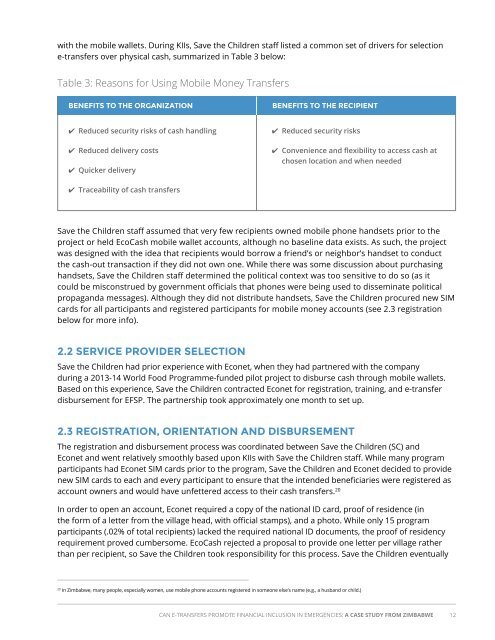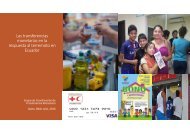Simatelele
2lF850q
2lF850q
Create successful ePaper yourself
Turn your PDF publications into a flip-book with our unique Google optimized e-Paper software.
with the mobile wallets. During KIIs, Save the Children staff listed a common set of drivers for selection<br />
e-transfers over physical cash, summarized in Table 3 below:<br />
Table 3: Reasons for Using Mobile Money Transfers<br />
BENEFITS TO THE ORGANIZATION<br />
BENEFITS TO THE RECIPIENT<br />
✔ Reduced security risks of cash handling<br />
✔ Reduced delivery costs<br />
✔ Quicker delivery<br />
✔ Reduced security risks<br />
✔ Convenience and flexibility to access cash at<br />
chosen location and when needed<br />
✔ Traceability of cash transfers<br />
Save the Children staff assumed that very few recipients owned mobile phone handsets prior to the<br />
project or held EcoCash mobile wallet accounts, although no baseline data exists. As such, the project<br />
was designed with the idea that recipients would borrow a friend’s or neighbor’s handset to conduct<br />
the cash-out transaction if they did not own one. While there was some discussion about purchasing<br />
handsets, Save the Children staff determined the political context was too sensitive to do so (as it<br />
could be misconstrued by government officials that phones were being used to disseminate political<br />
propaganda messages). Although they did not distribute handsets, Save the Children procured new SIM<br />
cards for all participants and registered participants for mobile money accounts (see 2.3 registration<br />
below for more info).<br />
2.2 SERVICE PROVIDER SELECTION<br />
Save the Children had prior experience with Econet, when they had partnered with the company<br />
during a 2013-14 World Food Programme-funded pilot project to disburse cash through mobile wallets.<br />
Based on this experience, Save the Children contracted Econet for registration, training, and e-transfer<br />
disbursement for EFSP. The partnership took approximately one month to set up.<br />
2.3 REGISTRATION, ORIENTATION AND DISBURSEMENT<br />
The registration and disbursement process was coordinated between Save the Children (SC) and<br />
Econet and went relatively smoothly based upon KIIs with Save the Children staff. While many program<br />
participants had Econet SIM cards prior to the program, Save the Children and Econet decided to provide<br />
new SIM cards to each and every participant to ensure that the intended beneficiaries were registered as<br />
account owners and would have unfettered access to their cash transfers. 20<br />
In order to open an account, Econet required a copy of the national ID card, proof of residence (in<br />
the form of a letter from the village head, with official stamps), and a photo. While only 15 program<br />
participants (.02% of total recipients) lacked the required national ID documents, the proof of residency<br />
requirement proved cumbersome. EcoCash rejected a proposal to provide one letter per village rather<br />
than per recipient, so Save the Children took responsibility for this process. Save the Children eventually<br />
20<br />
In Zimbabwe, many people, especially women, use mobile phone accounts registered in someone else’s name (e.g., a husband or child.)<br />
CAN E-TRANSFERS PROMOTE FINANCIAL INCLUSION IN EMERGENCIES: A CASE STUDY FROM ZIMBABWE 12



